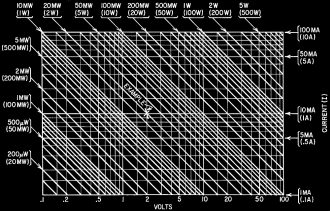|
March 1969 Radio-Electronics
 [Table of Contents] [Table of Contents]
Wax nostalgic about and learn from the history of early electronics.
See articles from Radio-Electronics,
published 1930-1988. All copyrights hereby acknowledged.
|
Charts and nomographs are
not nearly as useful or necessary today for the design and troubleshooting of
electronics due to the ready availability of calculators in the form of
computers, tablets, and smartphones. Determining parallel and series resistance,
capacitance, and inductance, reactance, power dissipation, resonant frequency,
voltage dividers, etc., can easily be done with the push of a few buttons (or
virtual touch-sensitive screen buttons). Not only is it not necessary to know
the equations behind the calculations, but you don't even need the know how to
enter mathematical operations into a calculator. A lot of old-schoolers say the
availability of newfangled electronic gizmos contributes to the dumbing down of
technicians and engineers. If you can't use a
slide
rule, then you don't truly understand the science. I wonder if their
attitudes were the same when special-purpose cardboard
slide calculators and even design charts like this one and
nomographs were
published?
Power Dissipation in Resistors or Transistors - Simple chart saves
calculations
 By Carl David Todd* By Carl David Todd*
A very simple chart can be used to compute the power dissipation in a resistor
or transistor. Once the power dissipation is known, the voltage limit for any given
current can be found or the maximum permissible current for a specified voltage
can be computed.
For example, if we know that a transistor's collector voltage is 2 V when collector
current is 10 ma, we can use the chart to compute collector power dissipated. We
enter the chart from the right along the 10-ma current line and proceed until we
intersect the vertical line representing 2 volts. Since they intersect on the 20
mw line, we know that power dissipation is 20 mw.
There are other ways to use the chart too. Let's assume that the maximum allowable
collector power dissipation is 20 mw and a collector voltage of 2 volts is to be
applied. We need to know the maximum collector current which may flow without exceeding
the maximum power dissipation limit. We enter the chart from the bottom along the
2-volt line, and proceed to the 20-mw line. Now, by observing the current line passing
through the point of intersection of the voltage and power lines, we find the current
limit is 10 ma.
In a similar manner, if the power dissipation and the current are known, we can
find the maximum voltage which may be applied without exceeding the power dissipation
limit. Thus, if any two of the values of voltage, current and power are known or
specified, the third may be found by using the chart.
To cover the desired range of currents, a double scale is used. The main scale
runs from 1 to 100 ma. The secondary scale runs from 100 ma to 10 amperes and the
values are enclosed in parentheses. The power scale also has two ranges: one from
100 μw to 10 watts and the other from 10 mw to 1,000 watts. Note that the values
for the latter scale are enclosed in parentheses and are used with the secondary
scale marked in the same manner.
While the chart is marked only in terms of current, voltage and power, it may
also be used for multiplying or dividing any two numbers. For example, the chart
may be used for computing resistance, voltage and current. The current scale is
retained, but the power scale is replaced by a voltage scale, so the line representing
1 mw now represents 1 mv and the line representing 1 watt now represents 1 volt.
The old voltage scale becomes the resistance scale with 1 volt replaced by 1 ohm,
etc. Again, if any two variables are known or specified, the third one may be found
by using the chart.
Though simply constructed, the chart is a useful tool for the circuit de-signer
or technician. It is not as accurate a job as a slide rule, but often is just as
adequate. The chance of a misplaced decimal point is considerably reduced, too.
* Chief engineer, Hughes Aircraft Co.
Posted June 5, 2023
|





























